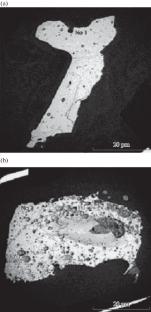近阶玻璃陨石模型
IF 0.5
Q4 MATERIALS SCIENCE, MULTIDISCIPLINARY
引用次数: 0
摘要
建立了近阶的透晶石-渗晶石模型。仿真依据的是x射线实验数据。在构建模型时,采用了最大熵法和Warren-Finbuck方法。模型的近序参数表明,与晶体玻璃和工业玻璃相比,tekite样品的微观结构高度无序。本文章由计算机程序翻译,如有差异,请以英文原文为准。

Models of Near Order of Tektites
Models of near order of tektites-irgizites were built. The simulation relies on data of X-ray experiment. When constructing models, the maximum entropy and Warren–Finbuck methods were used. The near order parameters of the models are indicative of the highly disordered microstructure of tektite samples, as compared to that of crystalline counterparts and industrial glasses.
求助全文
通过发布文献求助,成功后即可免费获取论文全文。
去求助
来源期刊

Inorganic Materials: Applied Research
Engineering-Engineering (all)
CiteScore
0.90
自引率
0.00%
发文量
199
期刊介绍:
Inorganic Materials: Applied Research contains translations of research articles devoted to applied aspects of inorganic materials. Best articles are selected from four Russian periodicals: Materialovedenie, Perspektivnye Materialy, Fizika i Khimiya Obrabotki Materialov, and Voprosy Materialovedeniya and translated into English. The journal reports recent achievements in materials science: physical and chemical bases of materials science; effects of synergism in composite materials; computer simulations; creation of new materials (including carbon-based materials and ceramics, semiconductors, superconductors, composite materials, polymers, materials for nuclear engineering, materials for aircraft and space engineering, materials for quantum electronics, materials for electronics and optoelectronics, materials for nuclear and thermonuclear power engineering, radiation-hardened materials, materials for use in medicine, etc.); analytical techniques; structure–property relationships; nanostructures and nanotechnologies; advanced technologies; use of hydrogen in structural materials; and economic and environmental issues. The journal also considers engineering issues of materials processing with plasma, high-gradient crystallization, laser technology, and ultrasonic technology. Currently the journal does not accept direct submissions, but submissions to one of the source journals is possible.
 求助内容:
求助内容: 应助结果提醒方式:
应助结果提醒方式:


